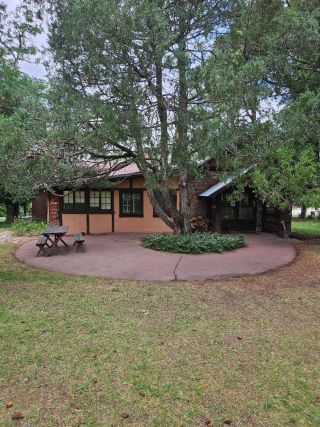Resilience
Oppenheimer, Los Alamos Ranch School, and Molding Character
Personal Perspective: The Greatest Generation built mentally tough athletes.
Updated October 8, 2023 Reviewed by Kaja Perina
Key points
- Experienced coaches may view today's kids as "soft," lacking resilience and mental toughness.
- Character and health were fundamental to progressive education and exemplified by the Los Alamos Ranch School.
- Respect, a "team first, me second" attitude, and self-discipline were demanded at Los Alamos Ranch School.

February 8, 1943.
A fateful date for the United States, Japan, and the Los Alamos Ranch School (LARS). It was the day the U.S. government shut down and occupied LARS, a private boys boarding school located in New Mexico.
Today, that site is etched in history as the home of the Manhattan Project, where some of the most brilliant scientists in history—including J. Robert Oppenheimer—gathered to create the atom bomb, dooming Hiroshima and Nagasaki, Japan, and ending WWII.

The blockbuster movie, Oppenheimer, briefly mentions the Los Alamos Ranch School, its grounds staging the hub of operations for the Manhattan Project.
The last four LARS graduates received their diplomas on Jan. 28, 1943, ending the school’s 26-year run that began in 1917. A sad finale for an exemplary educational institution, which claims such luminaries as Baseball Hall-of-Famer and team owner Bill Veeck, “Beat Generation” writer and artist William S. Burroughs, and influential writer and commentator Gore Vidal as former students

What does this have to do with athletics and sports psychology? Read on.
Resilience and Mental Toughness
Resilience and mental toughness are characteristics often lacking in today’s world, but not tolerated at the Los Alamos Ranch School and other educational institutions of that era. People talk about the importance of those traits for success in sport and other life endeavors and much has been written about them. An abundance of attention is focused these days on how to raise resilient, mentally tough kids.
Athletics are frequently viewed as a useful platform for the development of those qualities. Yet, experienced coaches often observe how “soft” today’s young athletes are. “Soft” is sports lingo for athletes lacking mental toughness. Much of that softness seems to be a result of the entitled, pampered upbringing that many modern-day youth have been saddled with, and discussed in a previous post (Stop Coddling Your Young Athlete | Psychology Today).
A few examples of “soft” young athletes can be observed at any youth sporting event—melting down in angered or befuddled puddles after a disappointing team or individual performance; heckling teammates when they err; or whining and complaining about things that don’t go their way. Coaches and parents often behave in a similar fashion, serving as bad role models, and distracting athletes from their performance tasks.
All that wasn’t allowed at LARS and other educational during the early- to mid-20th century, a time when society did not tolerate such behavior, placing an emphasis on developing high-character youth.
Parents and schools didn’t just talk the talk; they trained and demanded mental toughness and resilience. Thus, was created “the greatest generation,” Americans born in the late 19th and early 20th centuries, who led the United States to victory in World War II. Courageous men and women who prioritized the good of the nation (organization and team) over their personal needs. No whining and protesting by WWII-era civilians about gas and food rationing, blackout restrictions, and other homeland inconveniences.
Contrast that with how today’s generation responds to minor frustrations and inconveniences. Just watch a teenager when the Wi-Fi goes down. You’d think they were facing the apocalypse.
There’s much to be gained from learning how the “greatest generation” was created. We will examine how young people were trained and educated at the Los Alamos Ranch School as a prime example.
Ranch School Philosophy
The LARS mission can be summarized in two words—health and character—as explained by John D. Wirth and Linda Harvey Aldrich in their book, Los Alamos: The Ranch School Years 1917-1943 (2003).
Character-building wasn’t just a LARS thing. It was a primary objective of the progressive education movement, prominent during those years, at military schools, and esteemed eastern private schools such as Phillips Academy, (Massachusetts) and Phillips Exeter (New Hampshire), and other institutions.
Educator and scholar John Dewey was a major voice in the progressive education movement. Dewey advocated whole-person education, including “moral character,” defined by “shared social relationships, the disposition to determine one’s conduct and attitudes with reference to the welfare of the group” (Church & Sedlak, 1976). As LARS described it, according to Wirth and Aldrich, “It was in the quality of one’s relationships with others that character was most clearly revealed.”
The "welfare of the group" (organization, team, etc.) was prioritized over individualistic pursuits. Many of today’s young athletes are more focused on social status, personal statistics, and/or getting a college athletic scholarship than being a team, resulting in kids being in open, conflictual competition with their teammates, and bickering and belittling each other, resulting in fractured, dysfunctional teams, and undermining organizational success.
It also undermines sports scholarship pursuits. What college coach wants a selfish athlete?
LARS Character Training
Students were required to perform a minimum of one hour per weekday of community work (CW). We’re not talking about the disingenuous, box-checking, community service activities required at many high schools for college application purposes. This was committed, challenging CW.
An example of such community service at LARS occurred when a dam overflowed in Los Alamos Canyon in 1941, washing away part of an important road. All students, except the youngest (12- and 13-year-olds), dedicated long hours to clearing and rebuilding the road.
Parents of today would never tolerate such demands. Back then, moms and dads wanted their kids to have difficult challenges to build character and mental toughness.
Respect and Selflessness
Conduct was another key element of character emphasized at LARS.
“Hazing of fellow students was not tolerated to any degree,” as detailed by Wirth and Aldrich. “Selfishness, meanness to others, disrespect, lying, deviousness, ‘crabbing’ or complaining, and lack of cooperation” were not tolerated. Students were severely reprimanded for such behavior. Kids behaving in that manner, without effort to change, were not invited back to the school.
‘In running a school, we must consider carefully the effect of each boy on the group of boys, also on staff,’ Headmaster A.J. Connell advocated, according to Wirth and Aldrich. The authors shared an excerpt from a letter Connell sent to a student’s family, explaining their son was ‘very much spoiled, always wants to be an exception to every rule, has no idea of obedience or his duty toward others. A boy unwilling to do his part can never hope to make good in the west or anywhere else.’"
Another means of training selflessness was equine care. Each student was assigned a horse to care for and ride. Boys were required to tend to their horse before their own needs. It was another way of training unselfish, responsible behavior and character.
Building Resilience
Parents back then sent their kids to private schools to get them away from pampered home environs.
Today, families seek posh surroundings. Private schools and colleges oblige with the provision of every indulgence imaginable—including luxurious dormitories—to lure students to their school.
Indulgent provisions were not a thing at LARs or most other schools of that era. Living quarters were sparsely equipped. Students at many of those schools braved the rigors of unheated bathroom facilities, separated from the dorm, which included group shower rooms.
Ranch school students had one luxury not provided by many private schools of the time—indoor plumbing. They were, however, required to sleep in unheated, screened-in porches attached to their bedrooms—even during the cold winters of the Jemez Mountains. They were allowed to sleep in their rooms during extreme cold.
Optimal health was one objective of outdoor sleeping, exposing students to the clean mountain air that improved breathing. Resilience was another goal, training kids to acclimate to uncomfortable living conditions.
Students were encouraged to spend as much time outdoors for the same reasons. Shorts and shirtless (or short-sleeved shirts) were the order of each day, even in cooler weather. Outdoor, early-morning calisthenics in minimal attire was another daily requirement.
Contrast that with modern-day norms of parents demanding that schools close when it gets too cold, and then allow their kids to gleefully head for the sledding hill or ski slopes in those “dangerously” frigid conditions.
Takeaways
It’s time to revive the lost lessons of the greatest generation as exemplified by LARS and the progressive education movement.
Demanding, modeling, and training unselfish, high-character traits, such as a “team first, me second” attitude, mental toughness, respect for others, and a ceasing of the whining and complaining, so prevalent in today’s youth sports culture, will contribute to a winning team chemistry, and most importantly, build human beings with principled character.
Please reflect and find ways as a parent and coach on how to train, model, and encourage a team-first attitude, respect for others, mental toughness, and resilience for children. You don’t have to make kids sleep outside in wintry weather, but you can refrain from coddling and enabling them.
Failure to do so can result in negative lifetime consequences for society and flawed kids.
References
Church, R. & Sedlak, M. (1976). Education in the United States: An interpretive history. New York: Free Press
Wirth, J. & Aldrich, L. (2003). Los Alamos: The ranch school years. New Mexico: The University of New Mexico Press.




